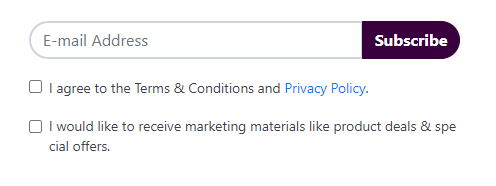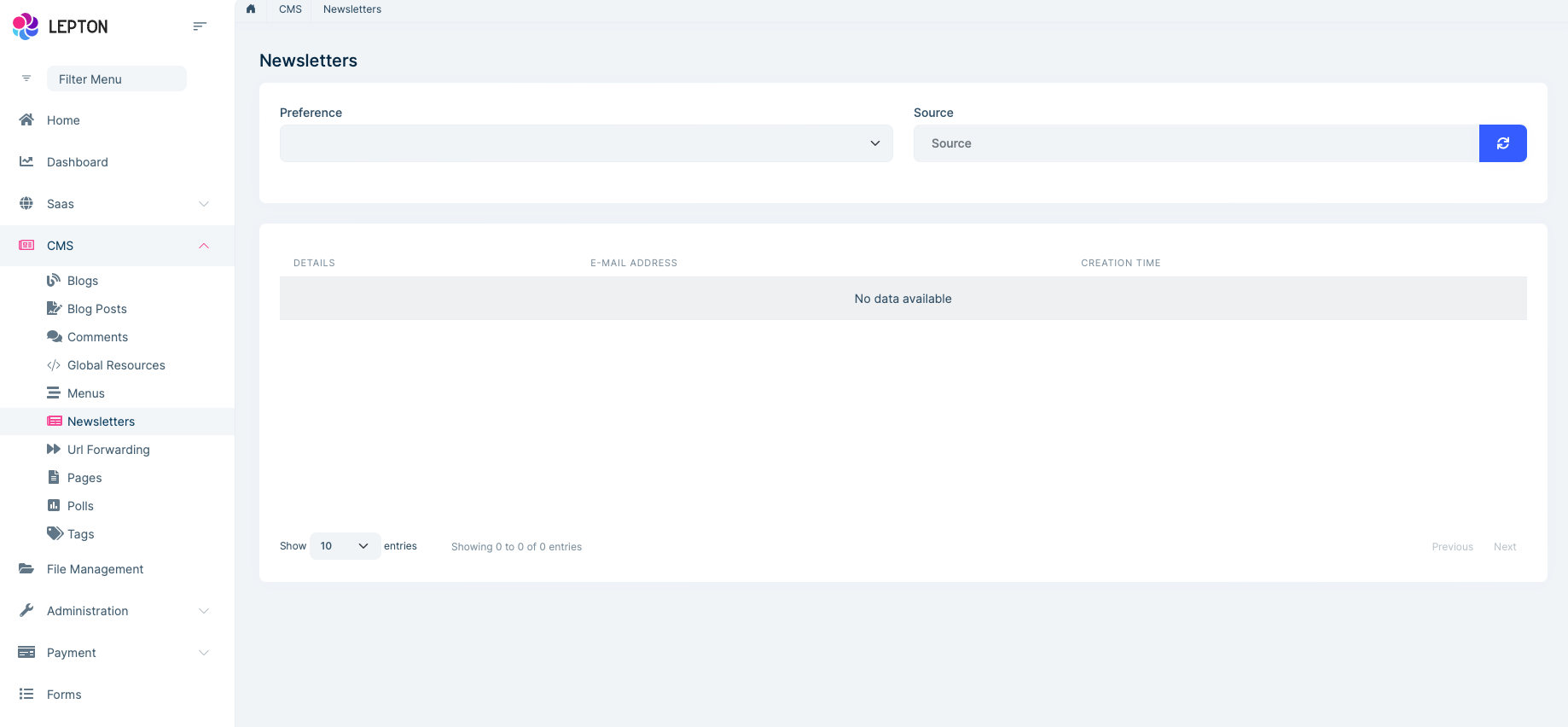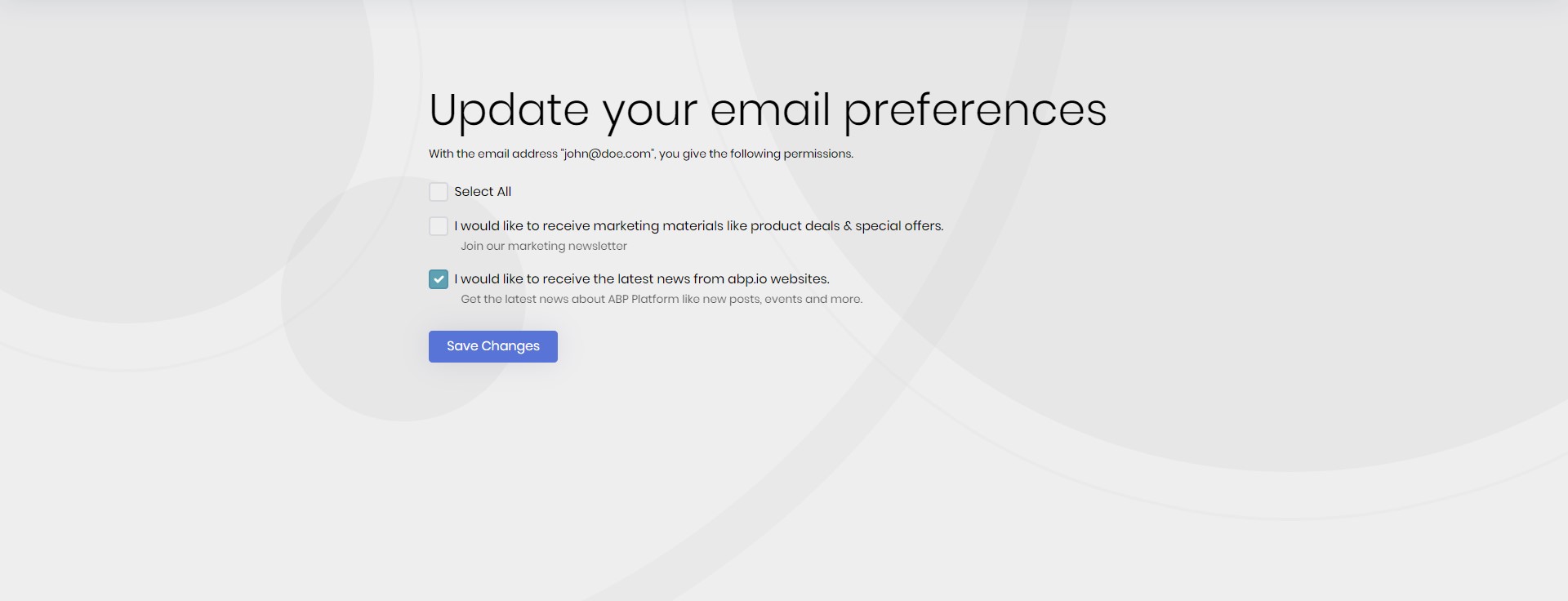Newsletter System
CMS kit provides a newsletter system to allow users to subscribe to newsletters. Here a screenshot of the newsletter subscription widget:

Enabling the Newsletter System
By default, CMS Kit features are disabled. Therefore, you need to enable the features you want, before starting to use it. You can use the Global Feature system to enable/disable CMS Kit features on development time. Alternatively, you can use the ABP Framework's Feature System to disable a CMS Kit feature on runtime.
Check the "How to Install" section of the CMS Kit Module documentation to see how to enable/disable CMS Kit features on development time.
User Interface
Menu Items
Newsletters: Opens the newsletter subscription management page.
Pages
Newsletters
You can then view the subscribers and export the list as CSV file, in the admin side of your solution:

Email Preferences Management
You (and users of your public web application) can manage your email preferences and unsubscribe from newsletters by visiting the Email Preferences page (/cms/newsletter/email-preferences), in the public side of your solution:

The Newsletter Subscription Widget
The newsletter subscription system provides a newsletter subscription widget to allow users to subscribe to a newsletter. You can simply place the widget on a page like below:
@await Component.InvokeAsync(
typeof(NewsletterViewComponent),
new
{
preference = "TechNewsletter",
source = "Footer",
requestAdditionalPreferencesLater = false
})
When you're adding the newsletter component, you can the specify source parameter to see where users subscribe to newsletters. See the options to understand the preferences.
Options
Before using the newsletter system, you need to define the preferences. You can use the NewsletterOptions type to define preferences. NewsletterOptions can be configured in the domain layer, in the ConfigureServices method of your module.
Example:
options.AddPreference("TechNewsletter",
new NewsletterPreferenceDefinition(
"Daily Technology Newsletter",
privacyPolicyConfirmation: "I accept the <a href='/privacy-policy'>Privacy Policy</a>.")
)
);
NewsletterOptions properties:
Preferences: List of defined newsletter preferences (NewsletterPreferenceDefinition) in the newsletter system.WidgetViewPath: Default view path for all newsletter preferences.
NewsletterPreferenceDefinition properties:
Preference: Name of the preference. We will use this field while displaying the newsletter component on the UI.PrivacyPolicyConfirmation: Privacy policy confirmation text shown in the newsletter subscription widget.AdditionalPreferences: Additional preference list that will show up after a user subscribes to the newsletter.WidgetPath: If you want to use a different newsletter widget instead of the default widget, you can specify the newsletter widget path using this field.
Internals
Domain Layer
Aggregates
This module follows the Entity Best Practices & Conventions guide.
NewsletterRecord
A newsletter record represents a newsletter subscription for a specific email address
NewsletterRecord(aggregate root): Represents a newsletter subscription in the system.
Repositories
This module follows the Repository Best Practices & Conventions guide.
Following custom repositories are defined for this feature:
INewsletterRecordRepository
Domain services
This module follows the Domain Services Best Practices & Conventions guide.
Newsletter Record Manager
NewsletterRecordManager is used to perform some operations for the NewsletterRecord aggregate root.
Application layer
Application services
NewsletterRecordAdminAppService(implementsINewsletterRecordAdminAppService): Implements the use cases of newsletter subscription management.NewsletterRecordPublicAppService(implementsINewsletterRecordPublicAppService): Implements the use cases of newsletter subscription for public websites.
Database providers
Common
Table / collection prefix & schema
All tables/collections use the Cms prefix by default. Set static properties on the CmsKitDbProperties class if you need to change the table prefix or set a schema name (if supported by your database provider).
Connection string
This module uses CmsKit for the connection string name. If you don't define a connection string with this name, it fallbacks to the Default connection string.
See the connection strings documentation for details.
Entity Framework Core
Tables
- CmsNewsletterRecords
- CmsNewsletterPreferences
MongoDB
Collections
- CmsNewsletterRecords
Entity Extensions
Check the "Entity Extensions" section of the CMS Kit Module documentation to see how to extend entities of the Newsletter Feature of the CMS Kit Pro module.


























































